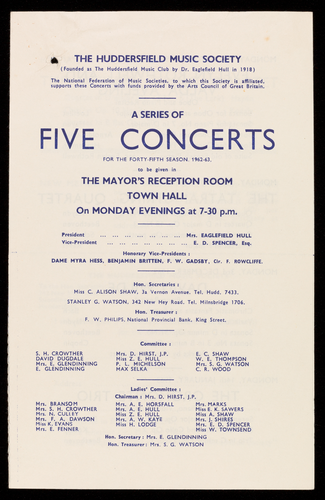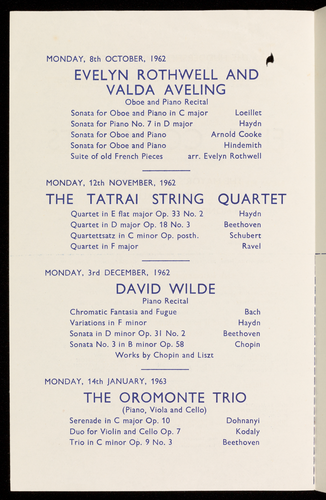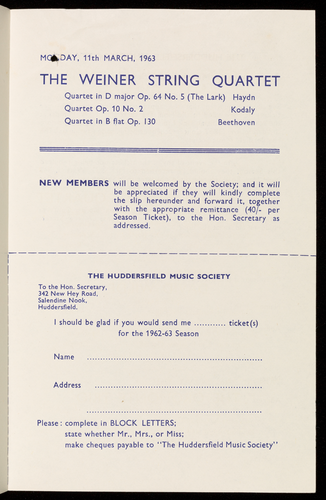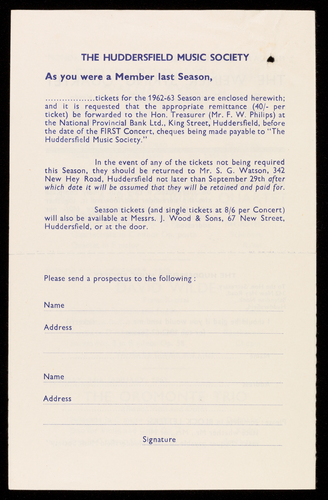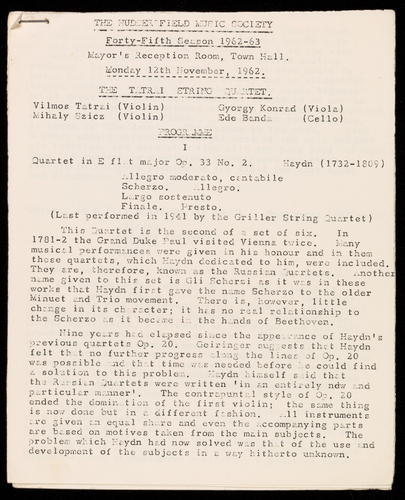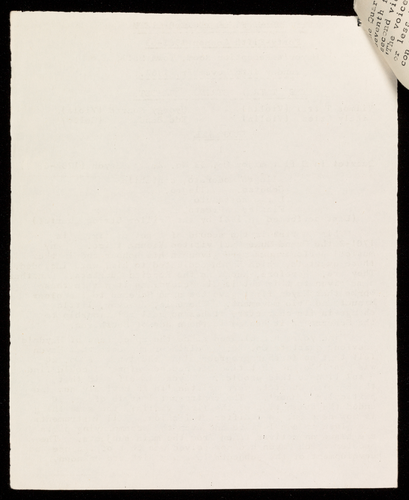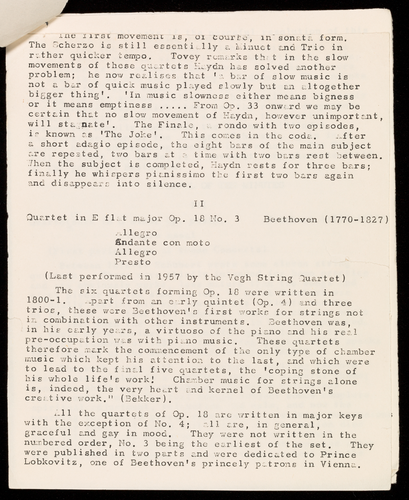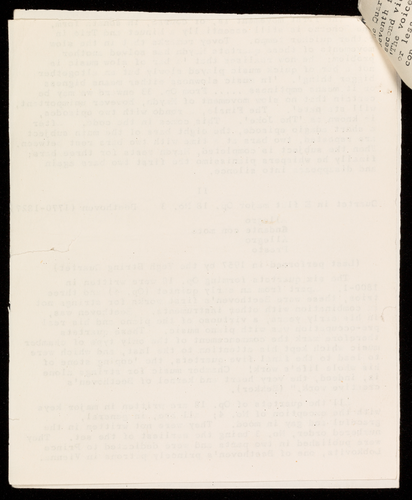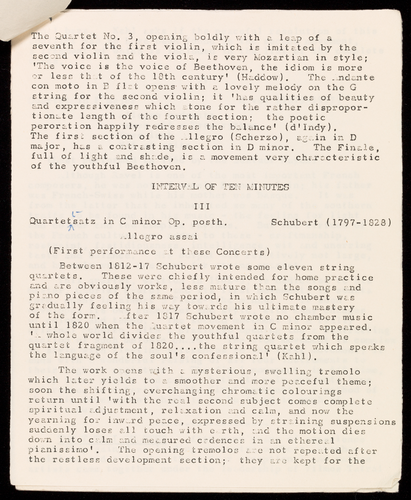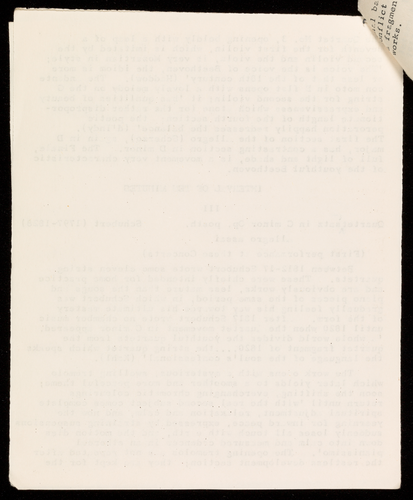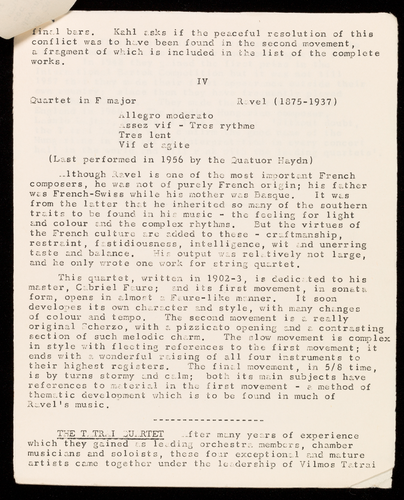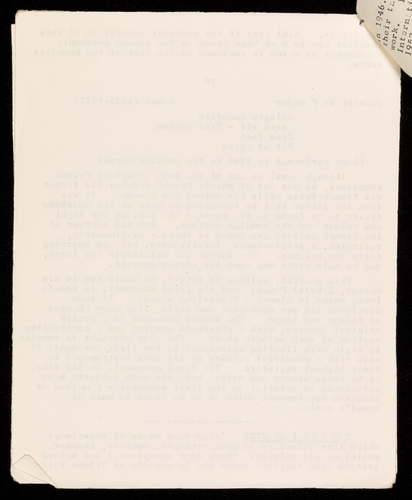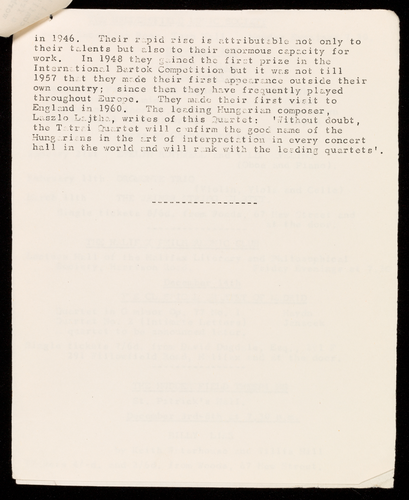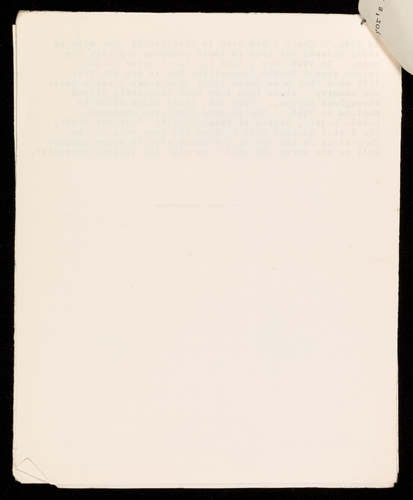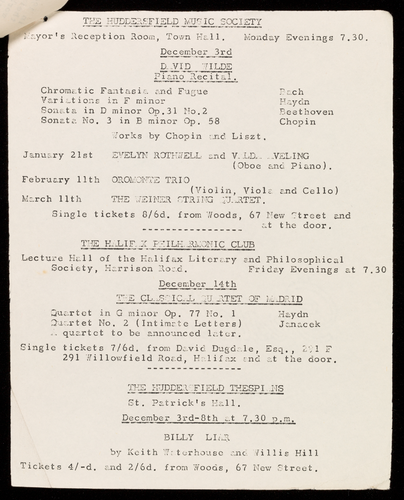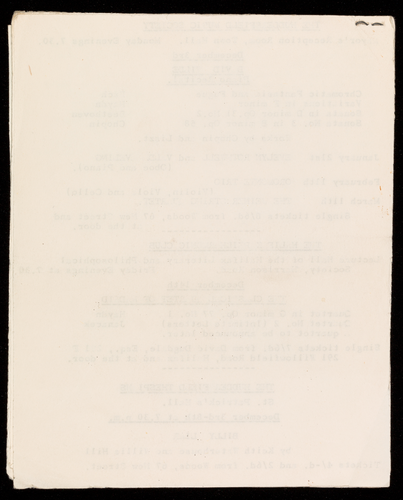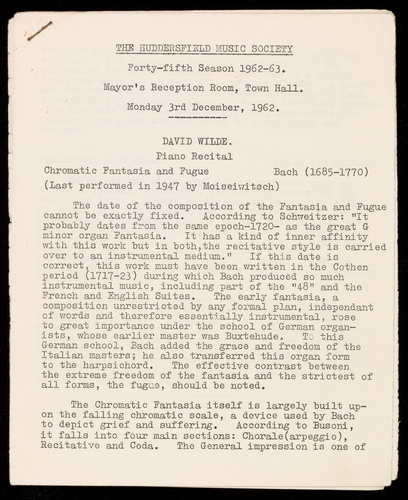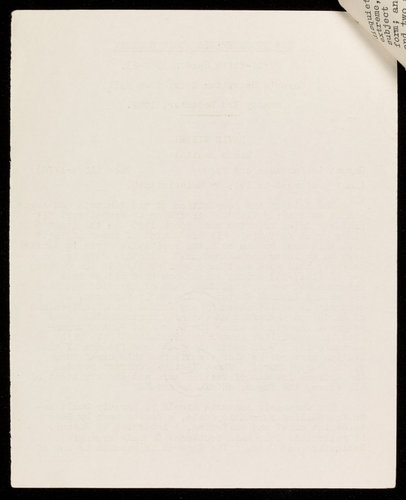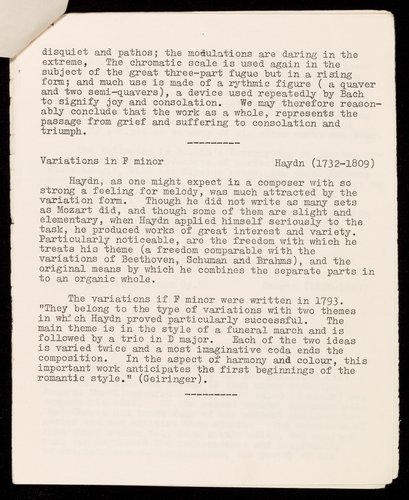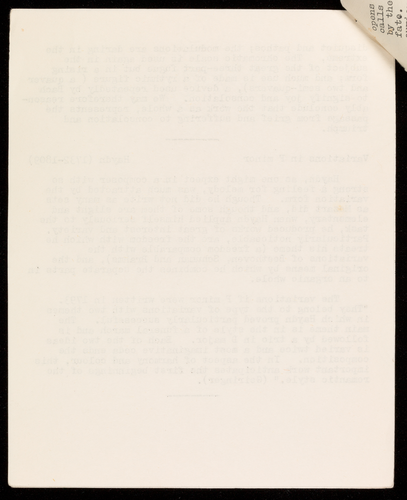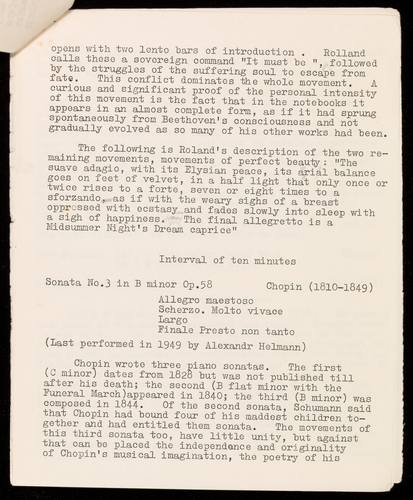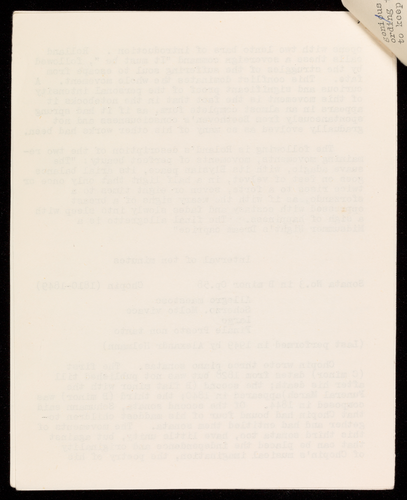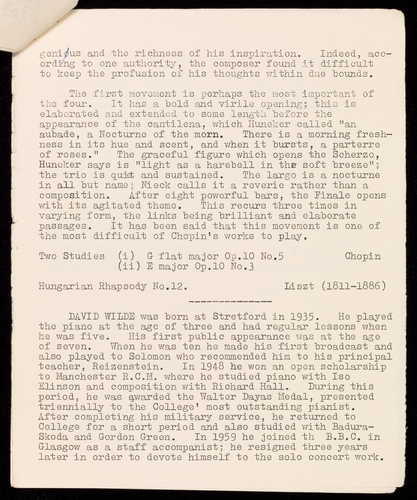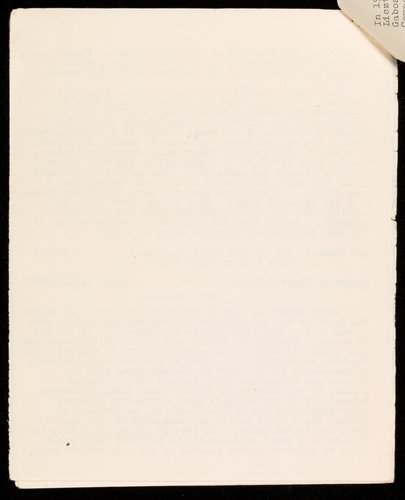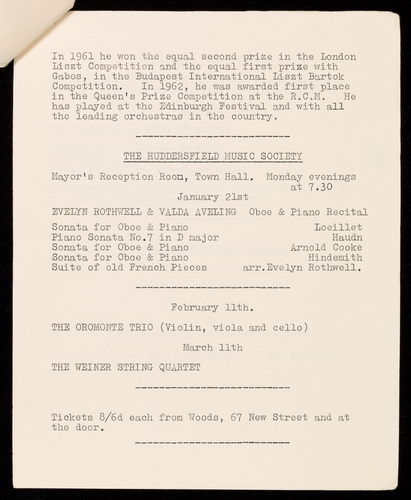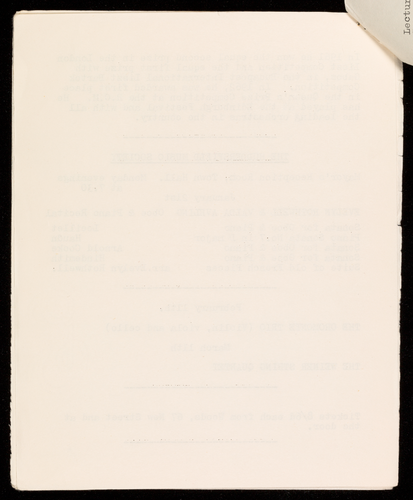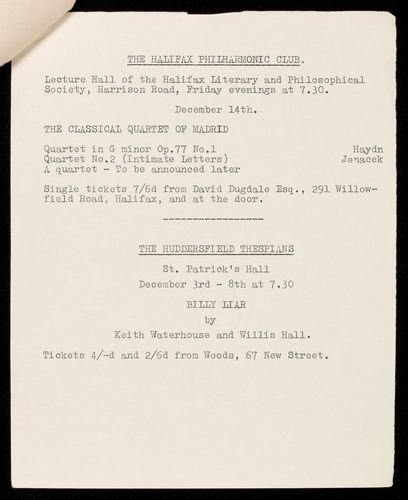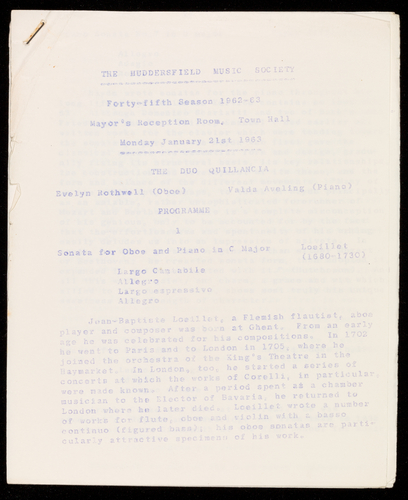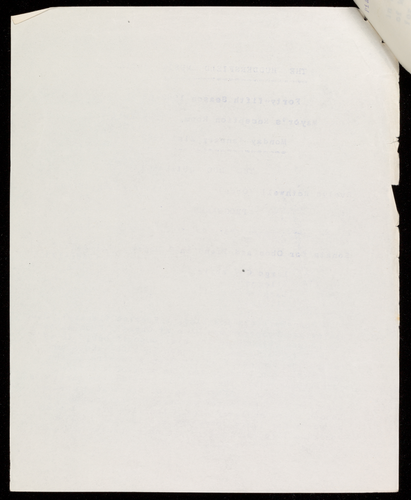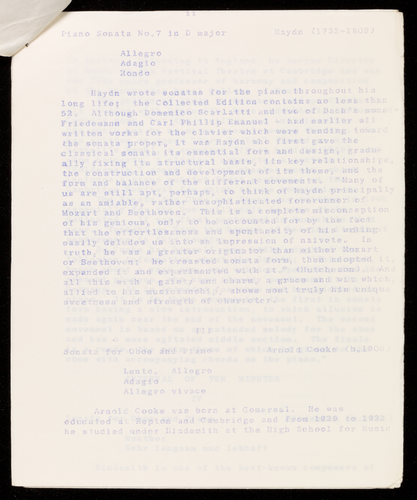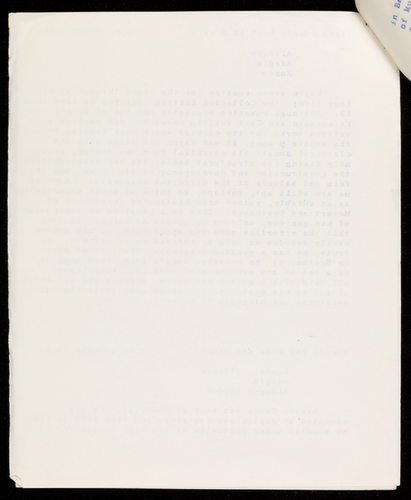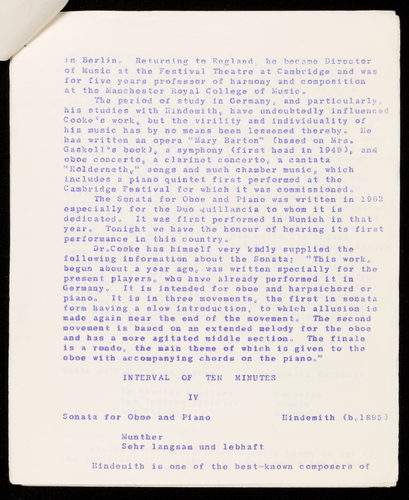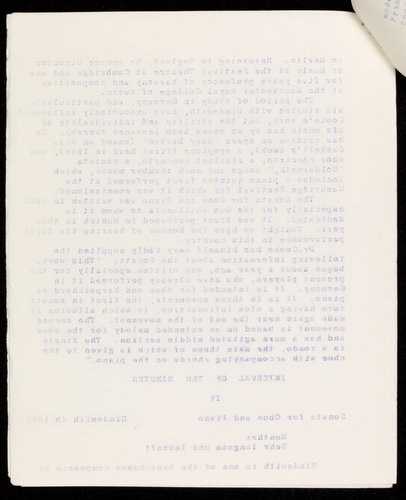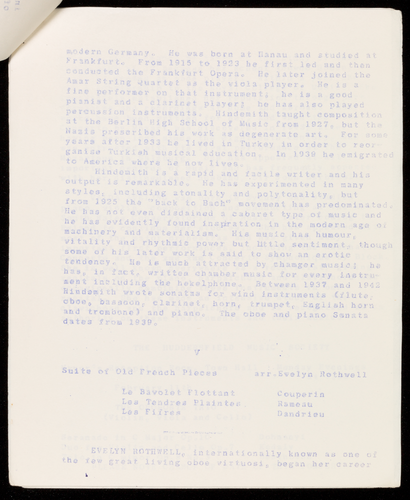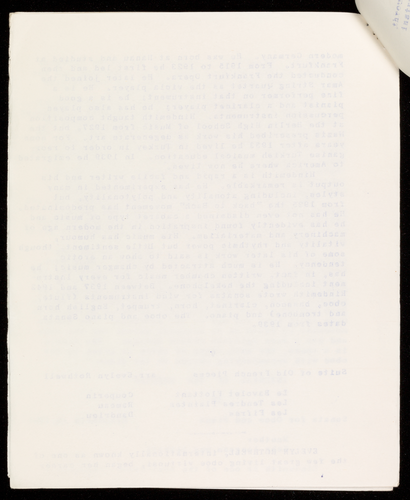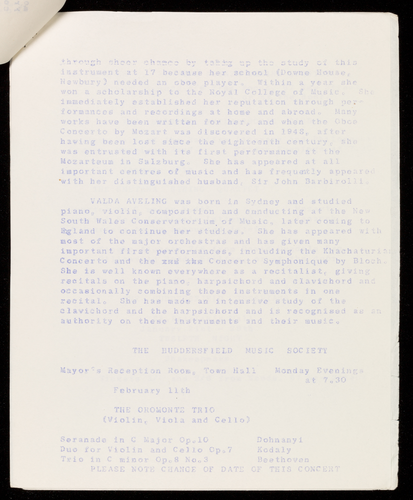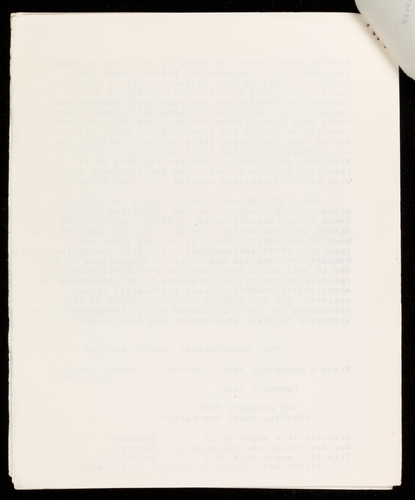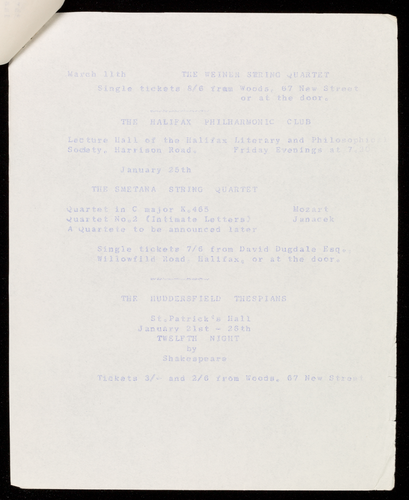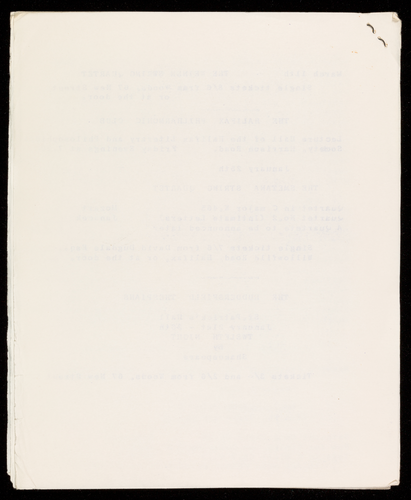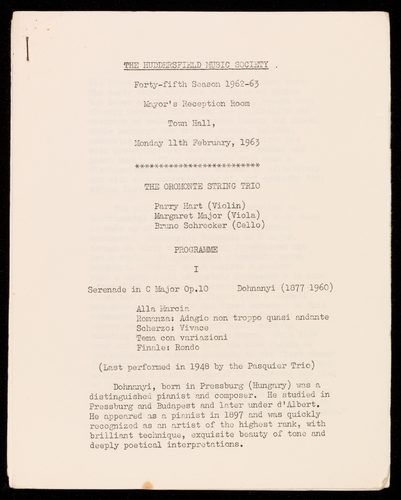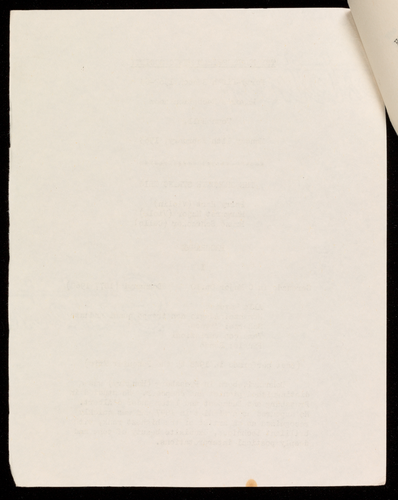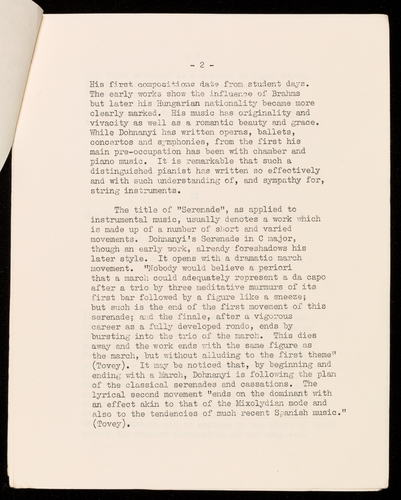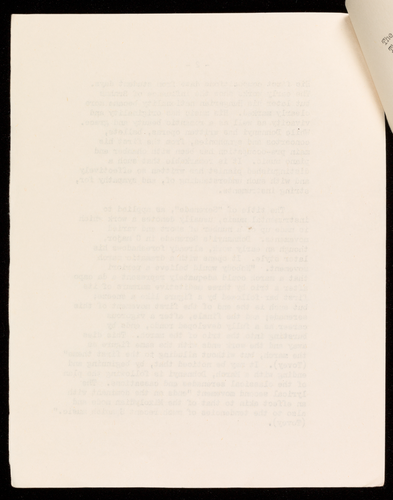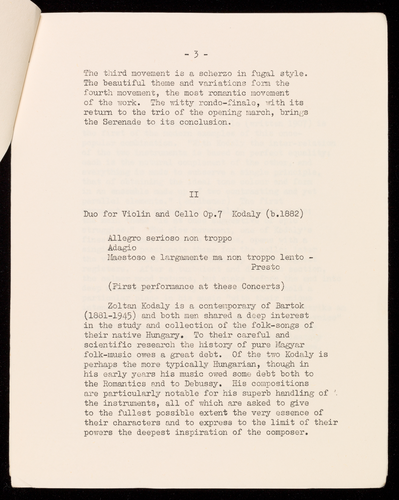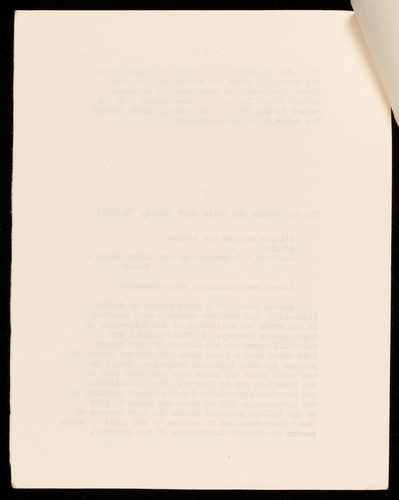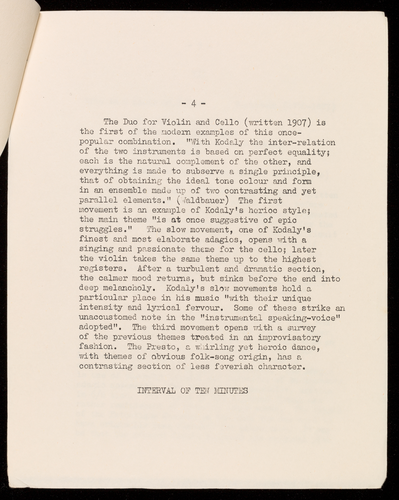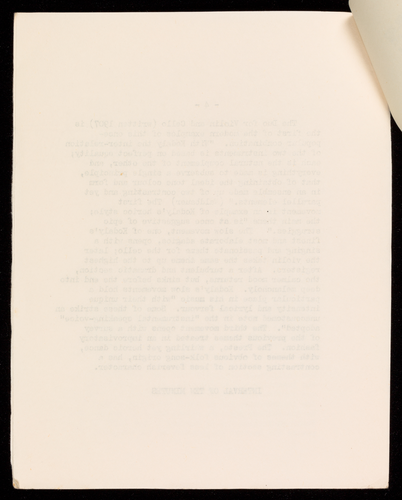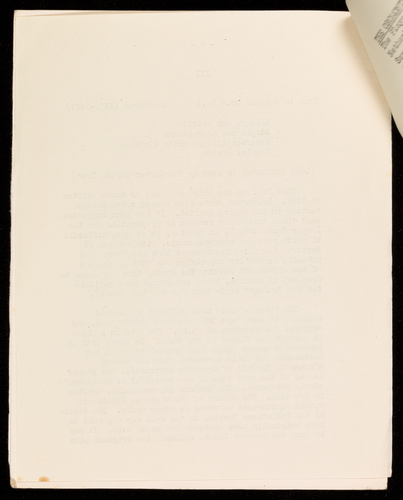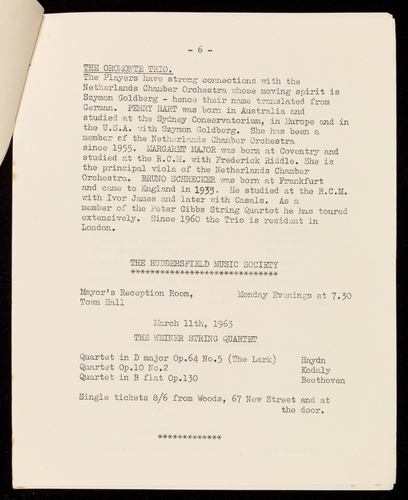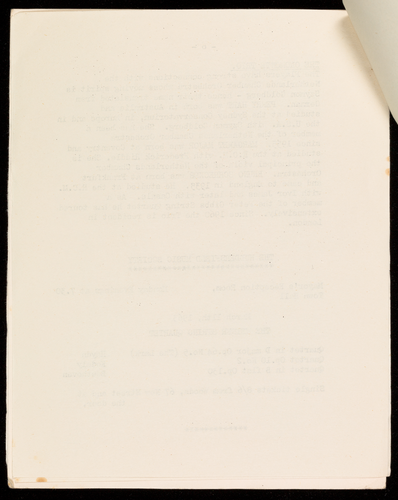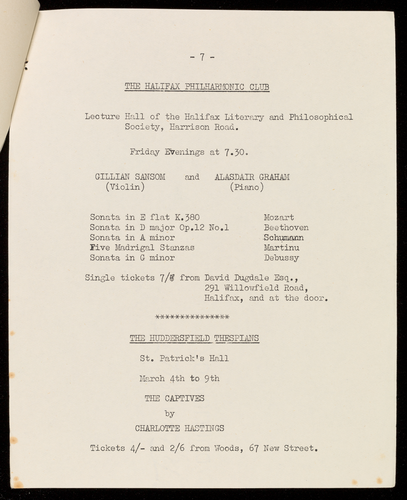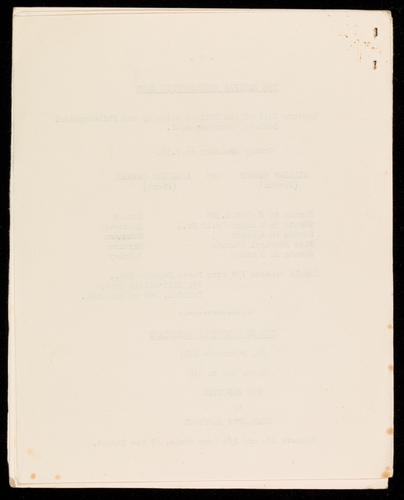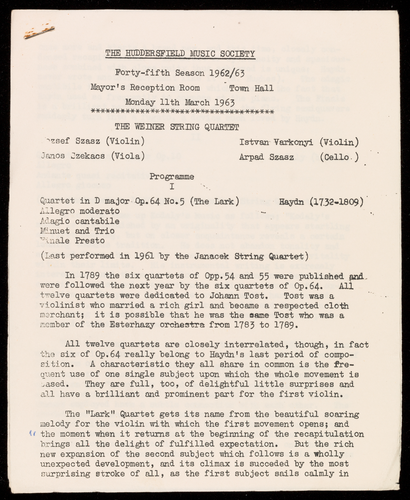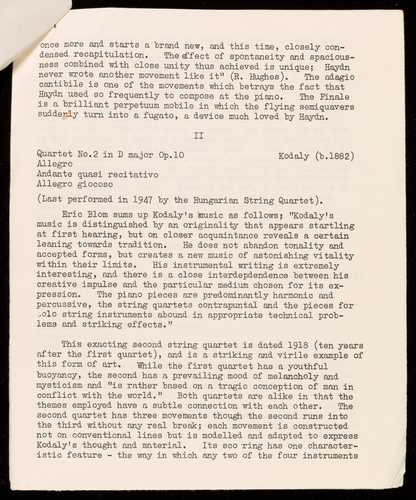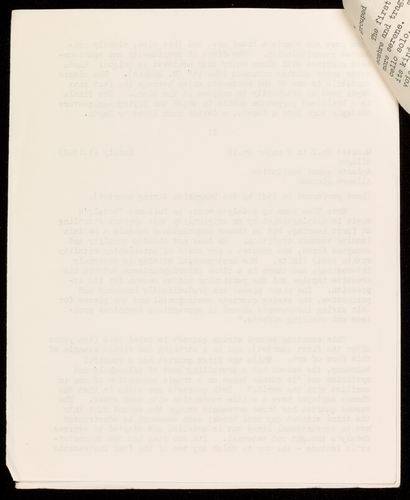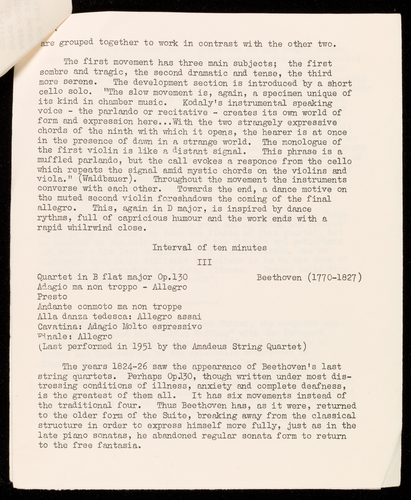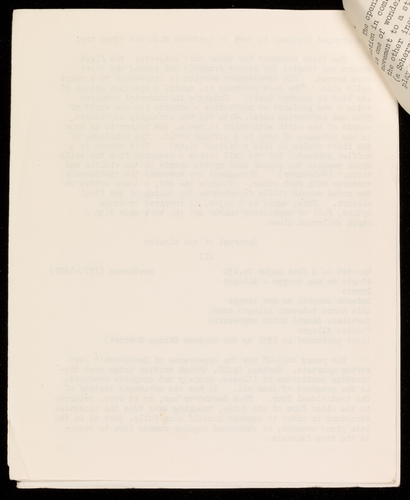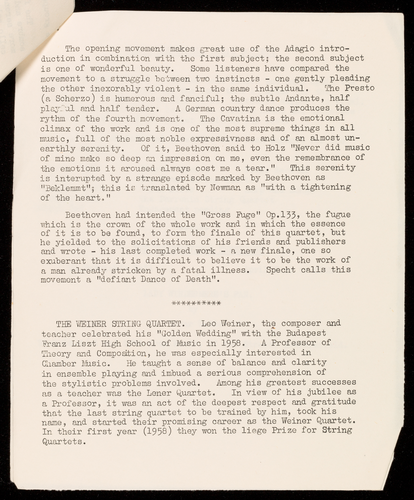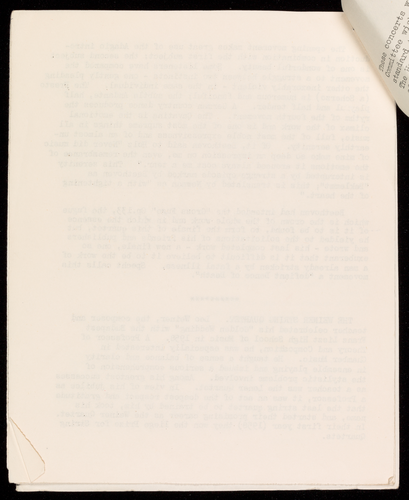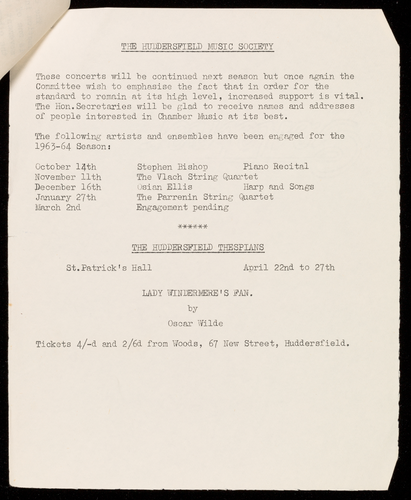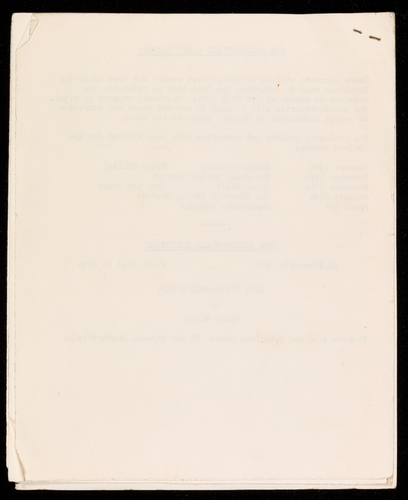Ocr'd Text:
THE HUDDERSFIELD MUSIC SOCIETY AGHOM
(Founded as The Huddersfield Music Club by Dr. Eaglefield Hull in 1918)
The National Federation of Music Societies, to which this Society is affiliated,
supports these Concerts with funds provided by the Arts Council of Great Britain.
FIVE
President
Vice-President
FOR THE FORTY-FIFTH SEASON. 1962-63,
to be given in
THE MAYOR'S RECEPTION ROOM
TOWN HALL
On MONDAY EVENINGS at 7-30 p.m.
A SERIES OF
S. H. CROWTHER
DAVID DUGDALE
Mrs. E. GLENDINNING
E. GLENDINNING
CONCERTS
Honorary Vice-Presidents :
DAME MYRA HESS, BENJAMIN BRITTEN, F. W. GADSBY, Cir. F. ROWCLIFFE.
Mrs. BRANSOM
Mrs. S. H. CROWTHER
Mrs. N. CULLEY
Hon. Secretaries :
Miss C. ALISON SHAW, 3a Vernon Avenue. Tel. Hudd. 7433.
STANLEY G. WATSON, 342 New Hey Road. Tel. Milnsbridge 1706.
Hon. Treasurer:
F. W. PHILIPS, National Provincial Bank, King Street.
Mrs. F. A. DAWSON
Miss K. EVANS
Mrs. E. FENNER
Mrs. EAGLEFIELD HULL
E. D. SPENCER, Esq.
Committee :
Mrs. D. HIRST, J.P.
Miss Z. E. HULL
P. L. MICHELSON
MAX SELKA
E. C. SHAW
W. E. THOMPSON
Mrs. S. G. WATSON
C. R. WOOD
Ladies' Committee:
Chairman: Mrs. D. HIRST, J.P.
Mrs. A. E. HORSFALL
Mrs. A. E. HULL
Miss Z. E. HULL
Mrs. A. W. KAYE
Miss H. LODGE
Mrs. MARKS
Miss E. K. SAWERS
Miss A. SHAW
Mrs. J. SHIRES
Mrs. E. D. SPENCER
Miss W. TOWNSEND
Hon. Secretary: Mrs. E. GLENDINNING
Hon. Treasurer: Mrs. S. G. WATSON
Ocr'd Text:
MONDAY, 8th OCTOBER, 1962
EVELYN ROTHWELL AND
VALDA AVELING
Oboe and Piano Recital
Sonata for Oboe and Piano in C major
Sonata for Piano No. 7 in D major
Sonata for Oboe and Piano
Sonata for Oboe and Piano
Suite of old French Pieces
MONDAY, 12th NOVEMBER, 1962
THE TATRAI STRING
Quartet in E flat major Op. 33 No. 2
Quartet in D major Op. 18 No. 3
Quartettsatz in C minor Op. posth.
Quartet in F major
MONDAY, 3rd DECEMBER, 1962
Chromatic Fantasia and Fugue
Variations in F minor
DAVID WILDE
Piano Recital
Sonata in D minor Op. 31 No. 2
Sonata No. 3 in B minor Op. 58
Hindemith
arr. Evelyn Rothwell
Loeillet
Haydn
Arnold Cooke
MONDAY, 14th JANUARY, 1963
Works by Chopin and Liszt
THE OROMONTE
(Piano, Viola and Cello)
Serenade in C
major Op. 10
Duo for Violin and Cello Op. 7
Trio in C minor Op. 9 No. 3
QUARTET
Haydn
Beethoven
Schubert
Ravel
Bach
Haydn.
Beethoven
Chopin
TRIO
Dohnanyi
Kodaly
Beethoven
Ocr'd Text:
1
MONDAY, 11th MARCH, 1963
THE WEINER STRING
STRING
Quartet in D major Op. 64 No. 5 (The Lark) Haydn
Quartet Op. 10 No. 2
Kodaly
Quartet in B flat Op. 130
Beethoven
NEW MEMBERS will be welcomed by the Society; and it will
be appreciated if they will kindly complete
the slip hereunder and forward it, together
with the appropriate remittance (40/- per
Season Ticket), to the Hon. Secretary as
addressed.
To the Hon. Secretary,
342 New Hey Road,
Salendine Nook,
Huddersfield.
QUARTET
I should be glad if you would send me .....
for the 1962-63 Season
Name
THE HUDDERSFIELD MUSIC SOCIETY
Address
.... ticket (s)
.......
Please complete in BLOCK LETTERS;
state whether Mr., Mrs., or Miss;
make cheques payable to "The Huddersfield Music Society"
Ocr'd Text:
As you were a Member last Season,
......tickets for the 1962-63 Season are enclosed herewith;
and it is requested that the appropriate remittance (40/- per
ticket) be forwarded to the Hon. Treasurer (Mr. F. W. Philips) at
the National Provincial Bank Ltd., King Street, Huddersfield, before
the date of the FIRST Concert, cheques being made payable to "The
Huddersfield Music Society."
In the event of any of the tickets not being required
this Season, they should be returned to Mr. S. G. Watson, 342
New Hey Road, Huddersfield not later than September 29th after
which date it will be assumed that they will be retained and paid for.
THE HUDDERSFIELD MUSIC SOCIETY
Season tickets (and single tickets at 8/6 per Concert)
will also be available at Messrs. J. Wood & Sons, 67 New Street,
Huddersfield, or at the door.
Please send a prospectus to the following:
Name
Address
Name
Address
Signaturel
Ocr'd Text:
THE HUDDER FIELD MUSIC SOCIETY
Forty-Fifth Season 1962-63
Mayor's Reception Room, Town Hall.
Monday 12th November, 1962.
THE TATRAI STRING QUARTET.
Vilmos Tatrai (Violin)
Mihaly Szicz (Violin)
Gyorgy Konrad (Viola)
Ede Banda
(Cello)
PROGRAMME
I
Quartet in E flat major Op. 33 No. 2.
Haydn (1732-1809)
llegro moderato, cantabile
Allegro.
Scherzo.
Largo sostenuto
Finale.
Presto.
(Last performed in 1941 by the Griller String Quartet)
This Quartet is the second of a set of six.
1781-2 the Grand Duke Paul visited Vienna twice.
musical performances were given in his honour and in them
these quartets, which Haydn dedicated to him, were included.
They are, therefore, known as the Russian Quartets. Another
neme given to this set is Gli Scherzi as it was in these
works that Haydn first gave the name Scherzo to the older
Minuet and Trio movement. There is, however, little
change in its character; it
the Scherzo as it became in
In
Many
has no real relationship to
the hands of Beethoven.
Nine years had elapsed since the appearance of Haydn's
previous quartets Op. 20. Geiringer suggests that Haydn
felt that no further progress along the lines of Op. 20
was possible and that time was needed before he could find
a solution to this problem. Haydn himself said that
the Rarsien Quartets were written in an entirely new and
particular manner'. The contrapuntal style of Op. 20
ended the domination of the first violin; the same thing
is now done but in a different fashion.
All instruments
are given an equal share and even the accompanying parts
are based on motives taken from the main subjects. The
problem which Haydn had now solved was that of the use and
development of the subjects in a way hitherto unknown.
Ocr'd Text:
e Quar
eventh f
second vi
or les
The voice
con
Ocr'd Text:
ine first movement is, of course, in sonata form.
The Scherzo is still essentially a Minuct and Trio in
rather quicker tempo. Tovey remarks tht in the slow
movements of these quartets Haydn has solved another
problem; he now realises that a bar of slow music is
not a bar of quick music played slowly but an altogether
bigger thing'. 'In music slowness either means bigness
or it means emptiness .... From Op. 33 onward we may be
certain that no slow movement of Haydn, however un important,
will stagnate'. The Finale, rondo with two episodes,
is known as 'The Joke¹. This comes in the code.
a short adagio episode, the eight bars of the main subject
are repeated, two bars at a time with two bars rest between.
When the subject is completed, Haydn rests for three bars;
finally he whispers pienissimo the first two bars again
and disappears into silence.
After
II
Quartet in E flat major Op. 18 No. 3 Beethoven (1770-1827)
Allegro
Andante con moto
Allegro
Presto
(Last performed in
1957 by the Vegh String Quartet)
The six quartets forming Op. 18 were written in
1800-1.
part from an early quintet (Op. 4) and three
trios, these were Beethoven's first works for strings not
in combination with other instruments. Beethoven was,
in his early years, a virtuoso of the piano and his real
pre-occupation was with piano music. These quartets
therefore mark the commencement of the only type of chamber
music which kept his attention to the last, and which were
to lead to the final five quartets, the 'coping stone of
his whole life's work! Chamber music for strings alone
is, indeed, the very heart and kernel of Beethoven's
creative work." (Bekker).
11 the quartets of Op. 18 are written in major keys
with the exception of No. 4; all are, in general,
graceful and gay in mood. They were not written in the
numbered order, No. 3 being the earliest of the set.
They
were published in two parts and were dedicated to Prince
Lobkovitz, one of Beethoven's princely patrons in Vienna.
Ocr'd Text:
e Quar
seventh
second vi
or les
The voice
con
Ocr'd Text:
The Quartet No. 3, opening boldly with a leap of a
seventh for the first violin, which is imitated by the
second violin and the viola, is very Mozartian in style;
The voice is the voice of Beethoven, the idiom is more
or less that of the 18th century' (Haddow). The ndante
con moto in E flat opens with a lovely melody on the G
string for the second violin; it has qualities of beauty
and expressiveness which atone for the rather dispropor-
tion te length of the fourth section; the poetic
peroration happily redresses the balance (d'Indy).
The first section of the llegro (Scherzo), again in D
major, has a contrasting section in D minor. The Finale,
full of light and shade, is a movement very characteristic
of the youthful Beethoven.
INTERVAL OF TEN MINUTES
III
Quartetsatz in C minor Op. posth.
llegro assai
Schubert (1797-1828)
(First performance at these Concerts)
Between 1812-17 Schubert wrote some eleven string
quartets. These were chiefly intended for home practice
and are obviously works, less mature than the songs and
piano pieces of the same period, in which Schubert was
gradually feeling his way towards his ultimate mastery
of the form. ..fter 1817 Schubert wrote no chamber music
until 1820 when the Quartet movement in C minor appeared.
whole world divides the youthful quartets from the
quartet fragment of 1820....the string quartet which speaks
the language of the soul's confessional (Kahl).
The work opens with a mysterious, swelling tremolo
which later yields to a smoother and more peaceful theme;
soon the shifting, everchanging chromatic colourings
return until with the real second subject comes complete
spiritual adjustment, relaxation and calm, and now the
yearning for inward peace, expressed by straining suspensions
suddenly loses all touch with earth, and the motion dies
down into calm and measured cadences in an ethereal
pianissimo'.
The opening tremolos are not repeated after
the restless development section; they are kept for the
Ocr'd Text:
works.
uǝu83A
onflict
3q 127
D
Ocr'd Text:
final bars. Kahl asks if the peaceful resolution of this
conflict was to have been found in the second movement,
a fragment of which is included in the list of the complete
works.
Quartet in F major
Allegro moderato
Assez vif - Tres rythme
Tres lent
Vif et agite
(Last performed in 1956 by the Quatuor Haydn)
It was
..1though Ravel is one of the most important French
composers, he was not of purely French origin; his father
was French-Swiss while his mother was Basque.
from the latter that he inherited so many of the southern
traits to be found in his music - the feeling for light
and colour and the complex rhythms. But the virtues of
the French culture are added to these - craftmanship,
restraint, fastidiousness, intelligence, wit and unerring
taste and balance. His output was relatively not large,
and he only wrote one work for string quartet.
4
IV
This quartet, written in 1902-3, is dedicated to his
master, Cabriel Faure; and its first movement, in sonata
form, opens in almost a Feure-like manner. It soon
developes its own character and style, with many changes
of colour and tempo. The second movement is a really
original Scherzo, with a pizzicato opening and a contrasting
section of such melodic charm. The slow movement is comp lex
in style with fleeting references to the first movement; it
ends with a wonderful raising of all four instruments to
their highest registers. The final movement, in 5/8 time,
is by turns stormy and calm; both its main subjects have
references to material in the first movement - e method of
thematic development which is to be found in much of
Ravel's music.
I
Ravel (1875-1937)
1
1
THE T TRAI QUARTET
fter many years of experience.
which they gained as leading orchestra members, chamber
musicians and soloists, these four exceptional and mature
artists came together under the leadership of Vilmos Tatrai
Ocr'd Text:
digit
coubor
ni bomsotzeg fand)
n
1946.
their ta
work.
Internat
1957
I
Ocr'd Text:
dow
in 1946. Their rapid rise is attributable not only to
their talents but also to their enormous capacity for
work. In 1948 they gained the first prize in the
International Bartok Competition but it was not till
1957 that they made their first appearance outside their
own country; since then they have frequently played
throughout Europe. They made their first visit to
England in 1960. The leading Hungarian composer,
Laszlo Lajthe, writes of this Quartet: 1 Without doubt,
the Tatrai Quartet will confirm the good name of the
Hungarians in the art of interpretation in every concert
hall in the world and will rank with the leading quartets'.
1
1
1
1
1
}
8
I
I
0
#
1
1
1
Ocr'd Text:
THE HUDDERSFIELD MUSIC SOCIETY
Mayor's Reception Room, Town Hall. Monday Evenings 7.30.
December 3rd
Chromatic Fantasia and Fugue
Variations in F minor
Sonata in D minor Op.31 No.2
Sonata No. 3 in B minor Op. 58
January 21st
D.VID WILDE
Piano Recital.
February 11th
March 11th
Works by Chopin and Liszt.
EVELYN ROTHWELL and V. LD.
OROMONTE TRIO
Bach
Haydn
Beethoven
Chopin
(Violin, Viola and Cello)
THE WEINER STRING NRTET.
Single tickets 8/6d. from Woods, 67 New Street and
at the door.
VELING
(Oboe and Piano).
BILLY LIAR
THE HALIF X PHILHARMONIC CLUB
Lecture Hall of the Halifax Literary and Philosophical
Society, Harrison Rood.
Friday Evenings at 7.30
December 14th
THE CLASSICAL CURTET OF MADRID
Quartet in G minor Op. 77 No. 1
Quartet No. 2 (Intimate Letters)
quartet to be announced later.
Single tickets 7/6d. from David Dugdale, Esq., 291 F
291 Willowfield Road, Halifax and at the door.
Haydn
Janacek
THE HUDDERSFIELD THESPINS
St. Patrick's Hall.
December 3rd-8th at 7.30 p.m.
by Keith Waterhouse and Willis Hill
Tickets 4/-d. and 2/6d. from Woods, 67 New Street.
Ocr'd Text:
THE HUDDERSFIELD MUSIC SOCIETY
Forty-fifth Season 1962-63.
Mayor's Reception Room, Town Hall.
Monday 3rd December, 1962.
DAVID WILDE.
Piano Recital
Chromatic Fantasia and Fugue
(Last performed in 1947 by Moiseiwitsch)
Bach (1685-1770)
The date of the composition of the Fantasia and Fugue
cannot be exactly fixed. According to Schweitzer: "It
probably dates from the same epoch-1720- as the great G
minor organ Fantasia. It has a kind of inner affinity
with this work but in both, the recitative style is carried
over to an instrumental medium." If this date is
correct, this work must have been written in the Cothen
period (1717-23) during which Bach produced so much
instrumental music, including part of the "48" and the
French and English Suites. The early fantasia, a
composition unrestricted by any formal plan, independant
of words and therefore essentially instrumental, rose
to great importance under the school of German organ-
ists, whose earlier master was Buxtehude. To this
German school, Bach added the grace and freedom of the
Italian masters; he also transferred this organ form
to the harpsichord. The effective contrast between
the extreme freedom of the fantasia and the strictest of
all forms, the fugue, should be noted.
The Chromatic Fantasia itself is largely built up-
on the falling chromatic scale, a device used by Bach
to depict grief and suffering. According to Busoni,
it falls into four main sections: Chorale (arpeggio),
Recitative and Coda. The General impression is one of
Ocr'd Text:
disquiet
extreme
subject
form; an
and two :
9
Ocr'd Text:
disquiet and pathos; the modulations are daring in the
extreme, The chromatic scale is used again in the
subject of the great three-part fugue but in a rising
form; and much use is made of a rythmic figure (a quaver
and two semi-quavers), a device used repeatedly by Bach
to signify joy and consolation. We may therefore reason-
ably conclude that the work as a whole, represents the
passage from grief and suffering to consolation and
triumph.
Variations in F minor
Haydn (1732-1809)
Haydn, as one might expect in a composer with so
strong a feeling for melody, was much attracted by the
variation form. Though he did not write as many sets
as Mozart did, and though some of them are slight and
elementary, when Haydn applied himself seriously to the
task, he produced works of great interest and variety.
Particularly noticeable, are the freedom with which he
treats his theme (a freedom comparable with the
variations of Beethoven, Schuman and Brahms), and the
original means by which he combines the separate parts in
to an organic whole.
The variations if F minor were written in 1793.
"They belong to the type of variations with two themes.
in which Haydn proved particularly successful. The
main theme is in the style of a funeral march and is
followed by a trio in D major. Each of the two ideas
is varied twice and a most imaginative coda ends the
composition. In the aspect of harmony and colour, this
important work anticipates the first beginnings of the
romantic style." (Geiringer).
Ocr'd Text:
offt
AS
opens
calls
by the
fate.
Ocr'd Text:
Rolland
4
opens with two lento bars of introduction
calls these a sovereign command "It must be ", followed
by the struggles of the suffering soul to escape from
fate. This conflict dominates the whole movement.
curious and significant proof of the personal intensity
of this movement is the fact that in the notebooks it
appears in an almost complete form, as if it had sprung
spontaneously from Beethoven's consciousness and not
gradually evolved as so many of his other works had been.
The following is Roland's description of the two re-
maining movements, movements of perfect beauty: "The
suave adagio, with its Elysian peace, its arial balance
goes on feet of velvet, in a half light that only once or
twice rises to a forte, seven or eight times to a
sforzando, as if with the weary sighs of a breast
opprossed with ecstasy and fades slowly into sleep with
a sigh of happiness. The final allegretto is a
Midsummer Night's Dream caprice"
Interval of ten minutes
Sonata No.3 in B minor Op.58
A
Chopin (1810-1849)
Allegro maestoso
Scherzo. Molto vivace
Largo
Finale Presto non tanto
(Last performed in 1949 by Alexandr Helmann)
Chopin wrote three piano sonatas. The first
(C minor) dates from 1828 but was not published till
after his death; the second (B flat minor with the
Funeral March)appeared in 1840; the third (B minor) was
composed in 1844. Of the second sonata, Schumann said
that Chopin had bound four of his maddest children to-
gether and had entitled them sonata. The movements of
this third sonata too, have little unity, but against
that can be placed the independence and originality
of Chopin's musical imagination, the poetry of his
Ocr'd Text:
A
do Iw
(e18-0181) nagodo
00
YEE
qe
genibus
ording t
to keep
Ocr'd Text:
Indeed, acc-
genious and the richness of his inspiration.
ording to one authority, the composer found it difficult
to keep the profusion of his thoughts within due bounds.
The first movement is perhaps the most important of
the four. It has a bold and virile opening; this is
elaborated and extended to some length before the
appearance of the cantilena, which Huneker called "an
aubade, a Nocturne of the morn. There is a morning fresh-
ness in its hue and scent, and when it bursts, a parterre
of roses." The graceful figure which opens the Scherzo,
Huneker says is "light as a harebell in the soft breeze";
the trio is quiet and sustained. The largo is a nocturne
in all but name; Nieck calls it a reverie rather than a
composition. After eight powerful bars, the Finale opens
with its agitated theme. This recurs three times in
varying form, the links being brilliant and elaborate
passages. It has been said that this movement is one of
the most difficult of Chopin's works to play.
Two Studies (i) G flat major Op.10 No.5
(ii) E major Op.10 No.3
Hungarian Rhapsody No.12.
Chopin
Liszt (1811-1886)
DAVID WILDE was born at Stretford in 1935. He played
the piano at the age of three and had regular lessons when
he was five. His first public appearance was at the age
of seven. When he was ten he made his first broadcast and
also played to Solomon who recommended him to his principal
teacher, Reizenstein. In 1948 he won an open scholarship
to Manchester R.C.M. where he studied piano with Iso
Elinson and composition with Richard Hall. During this
period, he was awarded the Walter Dayas Medal, presented
triennially to the College' most outstanding pianist.
After completing his military service, he returned to
College for a short period and also studied with Badura-
Skoda and Gordon Green. In 1959 he joined th B.B.C. in
Glasgow as a staff accompanist; he resigned three years
later in order to devote himself to the solo concert work.
Ocr'd Text:
In 1961 he won the equal second prize in the London
Liszt Competition and the equal first prize with
Gabos, in the Budapest International Liszt Bartok.
Competition. In 1962, he was awarded first place
in the Queen's Prize Competition at the R.C.M. He
has played at the Edinburgh Festival and with all
the leading orchestras in the country.
THE HUDDERSFIELD MUSIC SOCIETY
Mayor's Reception Room, Town Hall. Monday evenings
at 7.30
January 21st
EVELYN ROTHWELL & VALDA AVELING Oboe & Piano Recital
Sonata for Oboe & Piano
Piano Sonata No.7 in D major
Sonata for Oboe & Piano
Sonata for Oboe & Piano
Suite of old French Pieces
Loeillet
Haudn
Arnold Cooke
THE WEINER STRING QUARTET
Hindemith
arr. Evelyn Rothwell.
February 11th.
THE OROMONTE TRIO (Violin, viola and cello)
March 11th
Tickets 8/6d each from Woods, 67 New Street and at
the door.
Ocr'd Text:
THE HALIFAX PHILHARMONIC CLUB.
Lecture Hall of the Halifax Literary and Philosophical
Society, Harrison Road, Friday evenings at 7.30.
December 14th.
THE CLASSICAL QUARTET OF MADRID
Quartet in G minor Op.77 No.1
Quartet No.2 (Intimate Letters)
A quartet - To be announced later
Single tickets 7/6d from David Dugdale Esq., 291 Willow-
field Road, Halifax, and at the door.
THE HUDDERSFIELD THESPIANS
St. Patrick's Hall
December 3rd - 8th at 7.30
Haydn
Janacek
BILLY LIAR
by
Keith Waterhouse and Willis Hall.
Tickets 4/-d and 2/6d from Woods, 67 New Street.
Ocr'd Text:
THE HUDDERSFIELD MUSIC
Forty-fifth Season 1962-63
Mayor's Reception Room,
Monday January 21st 1963
SOCIETY
0
Evelyn Rothwell (Oboe)
THE DUO QUILLANCIA
PROGRAMME
Valda Aveling (Piano)
Sonata for Oboe and Piano in C Major
Largo Cantabile
Allegro
Largo espressivo
Loeillet
(1680-1730)
From an early
In 1702
Jean-Baptiste Loeillet, a Flemish flautist, aboe
player and composer was born at Ghent.
age he was celebrated for his compositions.
he went to Paris and to London in 1705, where he
joined the orchestra of the King's Theatre in the
Haymarket. In London, too, he started
concerts at which the works of Corelli, in particular,
a chamber
After a period spent as
were made known.
musician to the Elector of Bavaria, he returned to
Loeillet wrote a number
London where he later died.
of works for flute, oboe and violin with a
continuo (figured bass); his oboe sonatas
cularly attractive specimens of his work.
are parti-
Ocr'd Text:
Piano Sonata No.7 in D major
Allegro
Adagio
Haydn (1732-1809)
Haydn wrote sopatas for the piano throughout his
long life; the Collected Edition contains no less than
52. Although Domenico Scarlatti and two of Bach's sons
Friedemann and Carl Phillip Emanuel - had earlier all
written works for the clavier which were tending toward
the sonata proper, it was Haydn who first gave the
classical sonata its essential form and design, gradu-
ally fixing its structural basis, its key relationships,
the construction and development of its theme, and the
form and balance of the different movements. Many of
us are still apt, perhaps, to think of Haydn principally
an amiable, rather un sophisticated forerunner of 962
Mozart and Beethoven. This is a complete misconception
of his genious, only to be accounted for by the facti
that the effortlessness and spontaneity of his writing
easily deludes us into an impression of naivete.
truth, he was a greater originator than either Mozart
or Beethoven; he creasted sonata form, then adopted it,
expanded it and experimented with it." (Hutcheson) .th And
all this with a gaiety and charm, a grace and wis which,
allied to his musicianship, shows most truly his unique
sweetness and strength of character.
Sonata for Oboe and Piano of whicArnold Cooke (b.1906)
Allegro
Adagio AL
Allegro vivace
Arnold Cooke was born at Gomersal.
educated at Repton and Cambridge and from 1929 to 1932
he studied under Hindemith at the High School for Music
U
Ocr'd Text:
6A
LR
Ids the ne
[9]
is dissoM
nm 30
x
Ocr'd Text:
in Berlin. Returning to England, he became Director
of Music at the Festival Theatre at Cambridge and was
for five years professor of harmony and composition
at the Manchester Royal College of Music.
The period of study in Germany, and particularly
his studies with indemith, have undoubtedly influenced
Cooke's work, but the virility and individuality of
his music has by no means been lessened thereby.
has written an opera "Mary Barton" (based on Mrs
Gaskell's book), a symphony (first head in 1949),
oboe concerto, a clarinet concerto, a cantata
"Holderneth," songs and much chamber music which
includes a piano quintet first performed at the
Cambridge Festival for which it was commissioned.
The Sonata for Oboe and Piano was written in 1962
especially for the Duo quillancia to whom it is
dedicated. It was first performed in Munich in that
year. Tonight we have the honour of hearing its first
performance in this country.
Dr.Cooke has himself very kindly supplied the
following information about the Sonata; This work,
begun about a year ago, was written specially for the
present players, who have already performed it in
Germany. It is intended for oboe and harpsichord or
piano. It is in three movements, the first in sonata
form having a slow introduction, to which allusion is
made again near the end of the movement. The second
movement is based on an extended melody for the oboe
and has a more agitated middle section. The finale
is a rondo, the main theme of which is given to the
oboe with accompanying chords on the piano."
INTERVAL OF TEN MINUTES
IV
and
Sonata for Oboe and Piano
lindemith (b.1895)
Munther
Sehr langsam und lebhaft
Hindemith is one of the best-known composers of
Ocr'd Text:
103 00220 6msood on basign
esw bas ogbladms3 ts satsedT
noktinoqmos bas yaoured to
of SAINTUIGH
Isvites! oft sa slauM to
soesslong eisov ovil nok
steedoasi ont ts
oleum to ogolfo layok
di lw esibute ald
jud now s'ex000
yderedt benoesol need eases on yd asd oleum ald
.es no beesd) "mojis& visk" sieqo na nottlaw and
hans ,COACI ni beed Jazil) yodgave s
beonouitai ylbetduobatu ovsd di imobil
to ylisubivibal bas qiliziv od
doldw ,olaum Todasdo dous bas agnos
sát te begroting $exit Jesakup oasiq s asbuloni
benotea immoo asw ti doldw sol Isvitas
2001 Al met diw asy onsil bas eodo xos stsno
sgbindes
odr
el ti modw of stoneflipy ord edt sot viisiosqas
betsolbob
jedt at doinuM ni bomsotzeq Jazit asw jI
Jesli ett gaixsed to Tuonod odt evąd ow $dgino sex
ystnuos' etdi ni oonG#**I*eq
odt bellqqua vibas viev 11semid and ox0o0,1G
row aldT";stanol edt tuods noitsmotai gniwollot
sdt zot viistosqa.netti anw oge soy s Juode auged
at 32 bomrolroq ybsеxis evid odw ,azsysiq jasestq
to brodoleqrad bas sodo yot bobastal al t1 game
disnoe at Jaxil edtetnomsvom ostný nt at I ons iq
al noleulis doldw of ,noit ou boxtal wole & gaivad #ro?
baoose SAT jasmevom sát to bas od Issa aisga obem
sodo ods tol yboism bebaetxe as no bound a insmevom
Bisnit SAT noijose eibbim betstigs 910m & aed bas
sit of nevig at dożdw to smedi aida sa obnor a El
consiq sdt no abiodo gatynaqwosos #Iw sodo
2 TUKIM MAŤ 10 JÁVIRTWI
(2081 d) dJimebaill
ons19 bas sodo tot stano?
ttsddol hou asegasi rde2
to 81020qmoo wond-feed od to eno at diinsbalH
pow
UEJA
C
Ocr'd Text:
to
ni
modern Germany. He was born at Ilanau and studied at
Frankfurt. From 1915 to 1923 be first led and then
conducted the Frankfurt Opera. He later joined the
Amar String Quartet as the viola player.
fine performer on that instrument; he is a good
pianist and a clarinet player;
has also played
percussion instruments. Hindemith taught composition
he
at the Berlin High School of Music from 1927, but the
Nazis prescribed his work as degenerate art.
years after 1933 he lived in Turkey in order to reor
ganise Turkish musical education, In 1939 he emigrated
to America where he now lives.
Hindemith is a rapid and facile writer and his
output is remarkable. He has experimented in many
styles, including atonality and polytonality, but
from 1925 the "back to Bach" movement has predominated.
He has not even disdained a cabaret type of music and
he has evidently found inspiration in the modern age of
machinery and materialism. His music has humour,
vitality and rhythmic power but little sentiment, though
some of his later work is said to show an erotic lo
tendency o He is much attracted by changer music;
has, in fact, written chamber music for every instru-
ment including the hekelphone. Between 1937 and 1942
Hindemith wrote sonatas for wind instruments (flute,
oboe, bassoon, clarinet, horn, trumpet, English horn
and trombone) and piano. The obce and piano Senata
dates from 1939.
V
Suite of Old French Pieces
Les Tendres Plaintes.
Les Fiires
arr.Evelyn Rothwell
Couperin
Rameau
Dandrieu
EVELYN ROTHWELL, internationally known as one of
the few great living oboe virtuosi, began her career
Ocr'd Text:
erer Mox
kasiq
ME
aslyše
tronidasm
nebast
ni jeed
ni nom
donex1 510 To silva
Ocr'd Text:
through cheer chance by taking up the study of this
instrument at 17 because her school (Downe House,
Newbury) needed an oboe player. Within a year she
won a scholarship to the Royal College of Music.
immediately established her reputation through per-
formances and recordings at home and abroad. Many
works have been written for her, and when the Oboe
Concerto by Mozart was discovered in 1948, after
having been lost since the eighteenth century, she
was entrusted with its first performance at the
Mozarteum in Salzburg. She has appeared at all
important centres of music and has frequently appeared
with her distinguished husband, Sir John Barbirolli.
VALDA AVELING was born in Sydney and studied
piano, violin, composition and conducting at the New
South Wales Conservatorium of Music, later coming to
England to continue her studies. She has appeared with
most of the major orchestras and has given many
important first performances, including the Khachaturian
Concerto and the xxx * Concerto Symphonique by Bloch.
She is well known everywhere as a recitalist, giving
recitals on the piano, harpsichord and clavichord and
occasionally combining these instruments in one
recital. She has made an intensive study of the
clavichord and the harpsichord and is recognised as
authority on these instruments and their music.
THE HUDDERSFIELD
Mayor's Reception Room, Town Hall Monday Evenings
February 11th
THE OROMONTE TRIO
(Violin, Viola and Cello)
Seranade in C Major Op.10
Duo for Violin and Cello Op.7
Trio in C minor Op.8 No.3
1
Dohnanyi
Kodaly
Beethoven
PLEASE NOTE CHANCE OF DATE OF THIS CONCERT
Ocr'd Text:
March 11th
THE WEINER SERING QUARTET
Single tickets 8/6 fram Woods, 67 New Street
or at the door.
HALIFAX PHILHARMONIC
Lecture Hall of the Halifax Literary and Philosophics
Society, Harrison Road.
Friday Evenings at 7.30
January 25th
THE SMETANA STRING QUARTET
Quartet in C major K.465
Quartet No.2 (Intimate Letters)
A Quartete to be announced later
Single tickets 7/6 from David Dugdale Esq..
Willowfild Road, Halifax, or at the door.
HUDDERSFIELD THESPIANS
St. Patrick's Hall
TWELF TH
Mozart
Janacek
0
Shakespeare
Tickets 3/- and 2/6 from Woods, 67 New Street
Ocr'd Text:
THE HUDDERSFIELD MUSIC SOCIETY
Forty-fifth Season 1962-63
Mayor's Reception Room
Town Hall,
Monday 11th February, 1963
***
THE OROMONTE STRING TRIO
Parry Hart (Violin)
Margaret Major (Viola)
Bruno Schrecker (Cello)
PROGRAMME
I
Serenade in C Major Op.10
**
Tema con variazioni
Finale: Rondo
Dohnanyi (1877-1960)
Alla Marcia
Romanza: Adagio non troppo quasi andante
Scherzo: Vivace
(Last performed in 1948 by the Pasquier Trio)
Dohnanyi, born in Pressburg (Hungary) was a
distinguished pianist and composer. He studied in
Pressburg and Budapest and later under d'Albert.
He appeared as a pianist in 1897 and was quickly
recognized as an artist of the highest rank, with
brilliant technique, exquisite beauty of tone and
deeply poetical interpretations.
Ocr'd Text:
4700
2-
His first compositione date from student days.
The early works show the influence of Brahms
but later his Hungarian nationality became more
clearly marked. His music has originality and
vivacity as well as a romantic beauty and grace.
While Dohnanyi has written operas, ballets,
concertos and symphonies, from the first his
main pre-occupation has been with chamber and
piano music. It is remarkable that such a
distinguished pianist has written so effectively
and with such understanding of, and sympathy for,
string instruments.
The title of "Serenade", as applied to
instrumental music, usually denotes a work which
is made up of a number of short and varied
movements. Dohnanyi's Serenade in C major,
though an early work, already foreshadows his
later style. It opens with a dramatic march
movement. "Nobody would believe a periori
that a march could adequately represent a da capo
after a trio by three meditative murmurs of its
first bar followed by a figure like a sneeze;
but such is the end of the first movement of this
serenade; and the finale, after a vigorous
career as a fully developed rondo, ends by
bursting into the trio of the march. This dies
away and the work ends with the same figure as
the march, but without alluding to the first theme"
(Tovey). It may be noticed that, by beginning and
ending with a March, Dohnanyi is following the plan
of the classical serenades and cassations. The
lyrical second movement "ends on the dominant with
an effect akin to that of the Mixolydian mode and
also to the tendencies of much recent Spanish music."
(Tovey).
Ocr'd Text:
YA
at
44
od beligg
gnista
prorit
The
7
Ocr'd Text:
- 3-
The third movement is a scherzo in fugal style.
The beautiful theme and variations form the
fourth movement, the most romantic movement
of the work. The witty rondo-finale, with its
return to the trio of the opening march, brings
the Serenade to its conclusion.
II
Duo for Violin and Cello Op.7 Kodaly (b.1882)
Allegro serioso non troppo
Adagio
Maestoso e largamente ma non troppo lento -
Presto
(First performance at these Concerts)
Zoltan Kodaly is a contemporary of Bartok.
(1881-1945) and both men shared a deep interest
in the study and collection of the folk-songs of
their native Hungary. To their careful and
scientific research the history of pure Magyar
folk-music owes a great debt. Of the two Kodaly is
perhaps the more typically Hungarian, though in
his early years his music owed some debt both to
the Romantics and to Debussy. His compositions
are particularly notable for his superb handling of
the instruments, all of which are asked to give
to the fullest possible extent the very essence of
their characters and to express to the limit of their
powers the deepest inspiration of the composer.
Ocr'd Text:
($88.) isbol 1.40
isbol
T.40 1160 bms wit
(HE)
(D)
rewog
Ocr'd Text:
- 4 -
The Duo for Violin and Cello (written 1907) is
the first of the modern examples of this once-
popular combination. "With Kodaly the inter-relation
of the two instruments is based on perfect equality;
each is the natural complement of the other, and
everything is made to subserve a single principle,
that of obtaining the ideal tone colour and form
in an ensemble made up of two contrasting and yet
parallel elements." (Waldbauer) The first
movement is an example of Kodaly's herioc style;
the main theme "is at once suggestive of epic
struggles." The slow movement, one of Kodaly's
finest and most elaborate adagios, opens with a
singing and passionate theme for the cello; later
the violin takes the same theme up to the highest
registers. After a turbulent and dramatic section,
the calmer mood returns, but sinks before the end into
deep melancholy. Kodaly's slow movements hold a
particular place in his music "with their unique
intensity and lyrical fervour. Some of these strike an
unaccustomed note in the "instrumental speaking-voice"
adopted". The third movement opens with a survey
of the previous themes treated in an improvisatory
fashion. The Presto, a whirling yet heroic dance,
with themes of abvious folk-song origin, has a
contrasting section of less feverish character.
INTERVAL OF TEN MINUTES
Ocr'd Text:
at (TORI nothw) of foo
(Toer
eigh
APTO
day, brus gatht
Jeril
00
olge to
otat bne erit proted
to exitta
consh
a and
IS
no Indaut
ed eximia dard
tovel
boom
a
vlononiem goob
Ocr'd Text:
- 5 --
III
Trio in C minor Op.9 No.3
Beethoven (1770-1827)
Allegro con spirito
Adagio con espressione
Scherzo: Allegro molto e vivace
Finale: Presto
(Last performed in 1945 by the Carter String Trio)
This Tric is the third of a set of three written
in 1797. Beethoven wrote five string trios before
turning to the string quartet. It has been suggested
that these trios were studies in preparation for the
larger form, though, in reality, it is more difficult
to write rich and sonorous music, with variety of
texture, for three instruments than for four. One
probable reason for the change was that by the end
of the eighteenth century the string trio had begun to
drop out of fashion, being considered more suitable
for the "galant" style than for the "new music".
The Trios of Op.9 have suffered undeserved
neglect; in some ways they are more mature than, and
surpass, the quartets of Op.18. The Trio in C major
is perhaps the finest of the three. It opens with an
impressive unison theme very typical of the later
Beethoven; the whole movement, with its use of
sforzandi, is full of dramatic contrasts. The Adagio
is one of the most tuneful and beautiful of Beethoven's
adagio movements. The Scherzo is, unusually, written
in 6/8 time. The themes of the vigorous Finale are
rather reminiscent of those in other works. The finale
of the Pathetique Sonata, in the same key was said to
have originally been sketched for piano trio. It may
be that the present finale replaced the original plan
Ocr'd Text:
(sersit) free
Set
Tine
FS
Ocr'd Text:
- 6-
Shere
THE OROMONTE TRIO.
The Players have strong connections with the
Netherlands Chamber Orchestra whose moving spirit is
Szymon Goldberg - hence their name translated from
German. PERRY HART was born in Australia and
studied at the Sydney Conservatorium, in Europe and in
the U.S.A. with Szymon Goldberg. She has been a
member of the Netherlands Chamber Orchestra
since 1955. MARGARET MAJOR was born at Coventry and
studied at the R.C.M. with Frederick Riddle. She is
the principal viola of the Netherlands Chamber
Orchestra. BRUNO SCHRECKER was born at Frankfurt
and came to England in 1935. He studied at the R.C.M.
with Ivor James and later with Casals. As a
member of the Peter Gibbs String Quartet he has toured
extensively. Since 1960 the Trio is resident in
London.
***
Cont
THE HUDDERSFIELD MUSIC SOCIETY
Mayor's Reception Room,
Town Hall
March 11th, 1963
THE WEINER STRING QUARTET
**
**
Monday Evenings at 7.30
Quartet in D major Op.64 No.5 (The Lark)
Quartet Op.10 No.2
Quartet in B flat Op.130
**
Single tickets 8/6 from Woods, 67 New Street and at
the door.
Haydn
Kodaly
Beethoven
Ocr'd Text:
at thi
me b
NOO
OU
061.00 +1 a
LOVI
ba
Ignia
Ocr'd Text:
THE HALIFAX PHILHARMONIC CLUB
- 7 -
Lecture Hall of the Halifax Literary and Philosophical
Society, Harrison Road.
Friday Evenings at 7.30.
GILLIAN SANSOM
(Violin)
and
Sonata in E flat K. 380
Sonata in D major Op.12 No.1
Sonata in A minor
Five Madrigal Stanzas
Sonata in G minor
***
ALASDAIR GRAHAM
(Piano)
Single tickets 7/6 from David Dugdale Esq.,
291 Willowfield Road,
Halifax, and at the door.
THE HUDDERSFIELD THESPIANS
*
St. Patrick's Hall
March 4th to 9th
THE CAPTIVES
Mozart
Beethoven
Schumann
Martinu
Debussy
by
CHARLOTTE HASTINGS
Tickets 4/- and 2/6 from Woods, 67 New Street.
Ocr'd Text:
4310 01 101
Iepingpao II bas v
$10
Foll
088.2
Lebged bived no
6a
pianoa
Ocr'd Text:
THE HUDDERSFIELD MUSIC SOCIETY
Forty-fifth Season 1962/63
Mayor's Reception Room
****
Monday 11th March 1963
******
***
Town Hall
THE WEINER STRING QUARTET
zsef Szasz (Violin)
Janos Jzekacs (Viola)
Programme
I
**
Istvan Varkonyi (Violin)
Arpad Szasz
(Cello.)
Quartet in D major Op.64 No.5 (The Lark)
Allegro moderato
Adagio cantabile
Minuet and Trio
inale Presto
(Last performed in 1961 by the Janacek String Quartet)
Haydn (1732-1809)
In 1789 the six quartets of Opp. 54 and 55 were published and
were followed the next year by the six quartets of Op. 64. All
twelve quartets were dedicated to Johann Tost. Tost was a
violinist who married a rich girl and became a respected cloth
merchant; it is possible that he was the same Tost who was a
member of the Esterhazy orchestra from 1783 to 1789.
All twelve quartets are closely interrelated, though, in fact
the six of Op.64 really belong to Haydn's last period of compo-
sition. A characteristic they all share in common is the fre-
quent use of one single subject upon which the whole movement is
based. They are full, too, of delightful little surprises and
all have a brilliant and prominent part for the first violin.
The "Lark" Quartet gets its name from the beautiful soaring
melody for the violin with which the first movement opens; and
the moment when it returns at the beginning of the recapitulation
brings all the delight of fulfilled expectation. But the rich
new expansion of the second subject which follows is a wholly
unexpected development, and its climax is succeded by the most
surprising stroke of all, as the first subject sails calmly in
Ocr'd Text:
ce more and
ensed recapit
ness combined
Haydn
cantibile
never wrote an
is
Ocr'd Text:
once more and starts a brand new, and this time, closely con-
densed recapitulation. The effect of spontaneity and spacious-
ness combined with close unity thus achieved is unique; Haydn
never wrote another movement like it" (R. Hughes). The adagio
cantibile is one of the movements which betrays the fact that
Haydn used so frequently to compose at the piano. The Finale
is a brilliant perpetuum mobile in which the flying semiquavers
suddenly turn into a fugato, a device much loved by Haydn.
II
Quartet No.2 in D major Op.10
Allegro
Andante quasi recitativo
Allegro giocoso
(Last performed in 1947 by the Hungarian String Quartet).
Kodaly (b.1882)
Eric Blom sums up Kodaly's music as follows; "Kodaly's
music is distinguished by an originality that appears startling
at first hearing, but on closer acquaintance reveals a certain.
leaning towards tradition. He does not abandon tonality and
accepted forms, but creates a new music of astonishing vitality
within their limits. His instrumental writing is extremely
interesting, and there is a close interdepdendence between his
creative impulse and the particular medium chosen for its ex-
pression. The piano pieces are predominantly harmonic and
percussive, the string quartets contrapuntal and the pieces for
solo string instruments abound in appropriate technical prob-
lems and striking effects."
This exacting second string quartet is dated 1918 (ten years.
after the first quartet), and is a striking and virile example of
this form of art. While the first quartet has a youthful
buoyancy, the second has a prevailing mood of melancholy and
mysticism and "is rather based on a tragic conception of man in
conflict with the world." Both quartets are alike in that the
themes employed have a subtle connection with each other. The
second quartet has three movements though the second runs into
the third without any real break; each movement is constructed
not on conventional lines but is modelled and adapted to express
Kodaly's thought and material.
istic feature the way in which
Its sco ring has one character-
any two of the four instruments
Ocr'd Text:
οτος οττοο
*aueTag oποι
8617 pue aqπος
7SITJ au
padnozo
●
TOA
NUTY S77
fo
BACLE
vd
rol
ΑΠΟΣΤΟ
OI
20
71
7. Bug
pa
Ocr'd Text:
are grouped together to work in contrast with the other two.
more serene.
The first movement has three main subjects; the first
sombre and tragic, the second dramatic and tense, the third
The development section is introduced by a short
cello solo. "The slow movement is, again, a specimen unique of
its kind in chamber music. Kodaly's instrumental speaking
voice - the parlando or recitative - creates its own world of
form and expression here...With the two strangely expressive
chords of the ninth with which it opens, the hearer is at once
in the presence of dawn in a strange world. The monologue of
the first violin is like a distant signal. This phrase is a
muffled parlando, but the call evokes a responce from the cello
which repeats the signal amid mystic chords on the violins and
viola." (Waldbauer).
Throughout the movement the instruments
converse with each other. Towards the end, a dance motive on
the muted second violin foreshadows the coming of the final
allegro. This, again in D major, is inspired by dance
rythms, full of capricious humour and the work ends with a
rapid whilrwind close.
Interval of ten minutes
III
Beethoven (1770-1827)
Quartet in B flat major Op.130
Adagio ma non troppo - Allegro
Presto
Andante conmoto ma non troppe
Alla danza tedesca: Allegro assai
Cavatina: Adagio Molto espressivo
Finale: Allegro.
(Last performed in 1951 by the Amadeus String Quartet)
The years 1824-26 saw the appearance of Beethoven's last
string quartets. Perhaps Op.130, though written under most dis-
tressing conditions of illness, anxiety and complete deafness,
is the greatest of them all. It has six movements instead of
the traditional four. Thus Beethoven has, as it were, returned
to the older form of the Suite, breaking away from the classical
structure in order to express himself more fully, just as in the
late piano sonatas, he abandoned regular sonata form to return
to the free fantasia.
Ocr'd Text:
fumm
Fuedo au
ywoo ut ποτροπ
is one of wonde:
(a Scherr
the other ing
play
75 € 07 fuawΘΛΟΠΙ
Ocr'd Text:
The opening movement makes great use of the Adagio intro-
duction in combination with the first subject; the second subject
is one of wonderful beauty. Some listeners have compared the
movement to a struggle between two instincts - one gently pleading
the other inexorably violent - in the same individual. The Presto
(a Scherzo) is humerous and fanciful; the subtle Andante, half
playful and half tender. A German country dance produces the
rythm of the fourth movement. The Cavatina is the emotional
climax of the work and is one of the most supreme things in all
music, full of the most noble expressivness and of an almost un-
earthly serenity. Of it, Beethoven said to Holz "Never did music
of mine make so deep an impression on me, even the remembrance of
the emotions it aroused always cost me a tear." This serenity
is interupted by a strange episode marked by Beethoven as
"Beklemmt"; this is translated by Newman as "with a tightening
of the heart.
Beethoven had intended the "Gross Fuge" Op.133, the fugue
which is the crown of the whole work and in which the essence
of it is to be found, to form the finale of this quartet, but
he yielded to the solicitations of his friends and publishers
and wrote - his last completed work - a new finale, one so
exuberant that it is difficult to believe it to be the work of
a man already stricken by a fatal illness. Specht calls this
movement a "defiant Dance of Death".
PARA
******
THE WEINER STRING QUARTET. Leo Weiner, the composer and
teacher celebrated his "Golden Wedding" with the Budapest
Franz Liszt High School of Music in 1958. A Professor of
Theory and Composition, he was especially interested in
Chamber Music. He taught a sense of balance and clarity
in ensemble playing and imbued a serious comprehension of
the stylistic problems involved. Among his greatest successes
as a teacher was the Lener Quartet. In view of his jubilee as
a Professor, it was an act of the deepest respect and gratitude
that the last string quartet to be trained by him, took his
name, and started their promising career as the Weiner Quartet.
In their first year (1958) they won the liege Prize for String
Quartets.
Ocr'd Text:
B0828
These concerts
standard
Committee wi
The
Ocr'd Text:
THE HUDDERSFIELD MUSIC SOCIETY
These concerts will be continued next season but once again the
Committee wish to emphasise the fact that in order for the
standard to remain at its high level, increased support is vital.
The Hon. Secretaries will be glad to receive names and addresses
of people interested in Chamber Music at its best.
The following artists and ensembles have been engaged for the
1963-64 Season:
October 14th
November 11th
December 16th
January 27th
March 2nd
Stephen Bishop
The Vlach String Quartet
Osian Ellis
The Parrenin String Quartet
Engagement pending
**
St. Patrick's Hall
Piano Recital
*****
Harp and Songs
THE HUDDERSFIELD THESPIANS
April 22nd to 27th
LADY WINDERMERE'S FAN.
by
Oscar Wilde
Tickets 4/-d and 2/6d from Woods, 67 New Street, Huddersfield.






































































 loading...
loading...